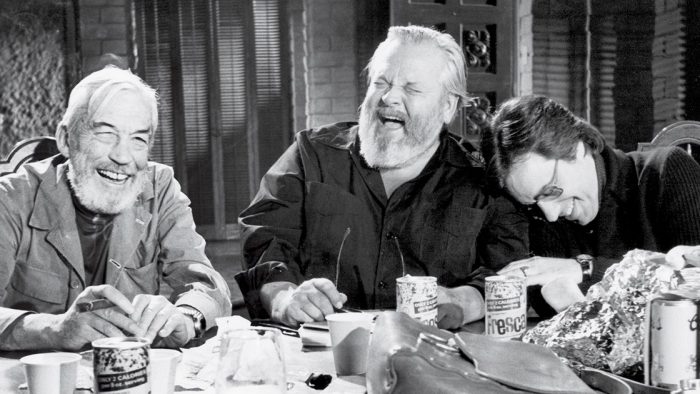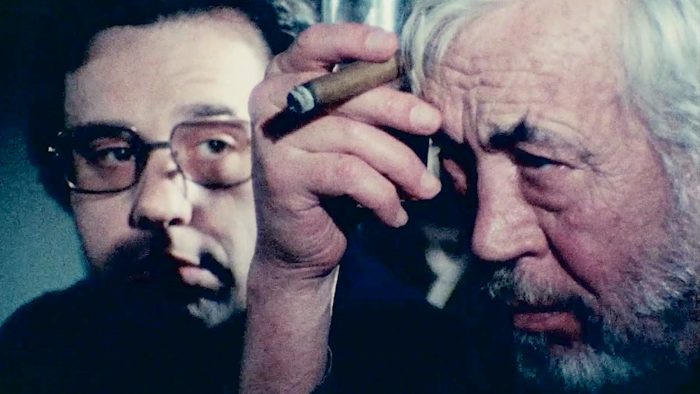Patrick Álvarez & Louis Leret recommends: ‘The Other Side of the Wind’ Review: Netflix Revives an Orson Welles Artifact [NYFF]

The Other Side of the Wind is finally complete — or rather “complete.” Nominally. The final film by the great Orson Welles (assuming The Deep never sees the light of day) begins with a title card explaining that this version, restored by the folks at Netflix, exists as “an attempt to honor and complete” Welles’ original vision, the key word being “attempt.” With so much footage left un-shot and unedited during its original production, no version of the film today can feel truly whole. And yet, despite its haphazard meandering, The Other Side of the Wind, in the form it will now be known, is a fascinating meta-textual artifact on the very piecing together of art and intention.
Despite Welles’ basing the film’s lead, director Jake Hannaford (John Huston), on the late Ernest Hemingway, one cannot but help peer into the past and see the aging, drunken Hannaford as an analogue for Welles himself. The film, which feels cobbled together from too many takes and angles, is framed through several fictitious layers that add up to a rightly mind-boggling whole. There’s The Other Side of the Wind, the Orson Welles mockumentary completed by Netflix. This 4:3 mockumentary is the story of Jake Hannaford’s The Other Side of the Wind, a last-ditch attempt at an avant-garde career revival, a dream-like film that Hannaford is unable to complete once his star walks off set. Then of course, there is Hannaford’s The Other Side of the Wind itself, a bizarre piece that we see unfold in all its Widescreen glory as Hannaford’s collaborators attempt to make sense of it. Finally, and perhaps most vitally, there’s the very framing of the mockumentary: the events we see, from the filming to the wrap-party to the screening of the Hannaford’s dailies, are presented to us posthumously; in the world of this mockumentary, Jake Hannaford, director of the fictitious The Other Side of the Wind, has died before completing the film. What glimpses of it we see are other people’s attempts to make sense of it.
Time is a strange thing. Decades after this concept was written and (mostly) filmed, we now bear witness to this very dynamic made real. “Shot Missing” says a screen as witnessed by those left to sort through Hannaford’s mess. “Shot Missing” indeed; Welles never managed to film Hannaford’s actual death scene. We’re told about it, rather than shown, so it never feels entirely real. As we see journalists and other filmmakers attempt to create their own version of Hannaford, often while interviewing him face to face — “Can one truly know the artist?” Welles seems to ask — the form this search for Hannaford takes is but a similarly attempted re-creation. An approximation, one might say, of Welles’ original intentions, drawn from decades of the man’s work and the notes he left behind. And yet, just as Hannaford’s final film was a departure from his norms (it plays like a half-formed Antonioni), The Other Side of the Wind feels unlike any other Welles production, more in line with John Cassavetes and his improvisational cinéma vérité than the formalism of Touch of Evil or Citizen Kane.

In the mockumentary, Huston’s John Hannaford, a man whose aura feels impenetrable, establishes a complicated relationship to religion and femininity. He believes God to be a woman, but he doesn’t respect God, considering himself above her. He empowers his actress Oja Kodar with a rifle, enlisting her help to shoot dummy doubles of the actor who left him, but he never lets her speak. Hannaford’s pseudo-religious musings undoubtedly cast the director in the role of The Creator — he is imposing, and those around him seem to worship him even while they question his motives — but the most interesting perspective on this dynamic comes from Hannaford’s protégé Brooks Otterlake (Peter Bogdanovich) who describes himself as an apostle; where other journalists struggle to piece together a coherent image of Hannaford and his work, Otterlake claims to be writing the definitive Hannaford memoir, from a place of proximity. In the world of cinema, where meaning is indirect to begin with, those with the power over its translation and transmutation are as important as the prophets themselves; who, finally, will determine the meaning of Hannaford’s work and his career?
Who, one might be compelled to ask, will determine what The Other Side of the Wind was truly meant to be?
The mockumentary portions of the film are disorienting, presenting Hannaford, Otterlake and others (including Susan Strasberg as Juliette Rich, a parody of Pauline Kael) from a multitude of perspectives, often in quick succession. The film switches rapidly from colour to black-and-white and back again as the viewing party for Hannaford’s still-incomplete film is captured from every conceivable angle. Everyone peers in on Hannaford. Everyone is interviewed about Hannaford, and one would think that from all these varying perspectives, a clear portrait might emerge. And yet, Hannaford’s actions remain mysterious — Why does he create and destroy so many doubles of the actor who abandoned him? Is it a display of power, or a search for it? — rendering the film’s own form, a found-footage medley from every external perspective, little more than a fool’s errand. No perspective featured in the mockumentary is Hannaford’s; the only time we see through his eyes are when his The Other Side of the Wind unfolds on screen and a studio boss attempts to discern the meaning of the scenes he shot; he is, expectedly, way off the mark, unable to interpret the most basic cinematic language. As last hurrahs go, this one is vicious.
There’s little sense to be made of Welles’ The Other Side of the Wind as a straightforward narrative — even at a mere two hours, it feels like a far lengthier affair — but in all its swapping between stories, timelines and perspectives, it proves to be an alluring experiment. The experiment in question is carried out not by Welle,s of course, but by Netflix (and by editor Bob Murawski) because what we’re seeing isn’t so much an Orson Welles film about the unknowability of the artist as it is that very unknowability made manifest. We were never going to see whatever Orson Welles had originally intended, though perhaps this best-case-scenario is rightfully obtuse, making even more impossible a truly complete understanding of an artist whose name we all know.
/Film Rating: 6 out of 10
The post ‘The Other Side of the Wind’ Review: Netflix Revives an Orson Welles Artifact [NYFF] appeared first on /Film.
View Source